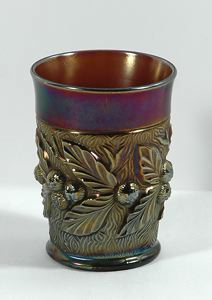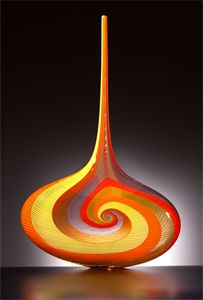
Harry Northwood (aka Northwood Glass Company)
American
This glass tumbler was manufactured by Harry Northwood at his glass factory in Wheeling, West Virginia in the early 1900s. It is a type of "carnival glass." This term refers to a deep green and purple irridescent glaze used in art glass that was inspired by Louis C. Tiffany’s Favrile glass from the late 1800s.
Tiffany created Favrile in an attempt to mimic the beautiful oxidation that was seen on the surface of excavated ancient glassware, caused by the deposit of minerals and deterioration of the glass body. Favrile became immensely popular, and was widely copied. The inexpensive version of this glassware was so commonly given away as prizes at carnivals and fairs that it earned the name "carnival glass."
Northwood is well known for using this iridescent glaze. He managed to produce it at an affordable cost so a middle-class family could enjoy its beauty. Its color was produced by iron in a low state of fusion. The matte texture is produced by rolling the finished glass in sand, which produces a lusterless surface. The relief with the massive berries and leaves was a popular design of the time.
American
Premium Glass Tumbler
1901–1910
Object Type:
Glass
Creation Place:
North America, American
Dimensions:
4 1/8 in. x Diam: x 3 1/8 in. (10.48 cm x 7.94 cm)
Medium and Support:
Pressed glass
Accession Number:
1961.0029
Credit Line:
Gift of Mrs. Lillian Martin
Currently On View
This glass tumbler was manufactured by Harry Northwood at his glass factory in Wheeling, West Virginia in the early 1900s. It is a type of "carnival glass." This term refers to a deep green and purple irridescent glaze used in art glass that was inspired by Louis C. Tiffany’s Favrile glass from the late 1800s.
Tiffany created Favrile in an attempt to mimic the beautiful oxidation that was seen on the surface of excavated ancient glassware, caused by the deposit of minerals and deterioration of the glass body. Favrile became immensely popular, and was widely copied. The inexpensive version of this glassware was so commonly given away as prizes at carnivals and fairs that it earned the name "carnival glass."
Northwood is well known for using this iridescent glaze. He managed to produce it at an affordable cost so a middle-class family could enjoy its beauty. Its color was produced by iron in a low state of fusion. The matte texture is produced by rolling the finished glass in sand, which produces a lusterless surface. The relief with the massive berries and leaves was a popular design of the time.
Keywords
Click a term to view the records with the same keyword
Portfolio List
Click a portfolio name to view all the objects in that portfolio
This object is a member of the following portfolios:
Your current search criteria is: Portfolio is "Artist Name: N".

 by Artist (13)
by Artist (13)
